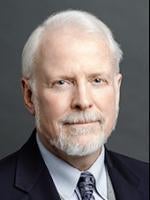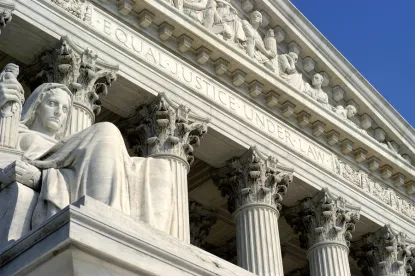On January 14, 2021, the U.S. Supreme Court issued an opinion addressing a split among circuit courts on whether an entity violates Section 362(a)(3) of the Bankruptcy Code’s automatic stay provision by passively retaining possession of a debtor’s property after a bankruptcy petition is filed. Section 362(a)(3) prohibits “any act . . . to exercise control over property” of the bankruptcy estate. 11 U.S.C. § 362(a)(3).1 This “automatic stay” provision is automatically triggered once a bankruptcy case is commenced, and is intended to give the debtor a breathing spell from its creditors, including from any collection efforts, foreclosures, and other actions creditors may take against a debtor’s property. The question here was whether the automatic stay provision in Section 362(a)(3) is also applicable to property already in the creditor’s possession at the time of the bankruptcy filing. In a unanimous2 decision authored by Justice Samuel Alito, the Supreme Court held that mere retention of estate property after the filing of a bankruptcy petition does not violate Section 362(a)(3). City of Chicago, Illinois v. Fulton, No. 19-357, 2021 WL 125106 (U.S. Jan. 14, 2021).
The Supreme Court’s decision provided at least some comfort to creditors that they are unlikely to be considered in violation of the stay under Section 362(a)(3) or incur related damages liability by merely passively retaining debtor property, including collateral, already in their possession. However, the decision did leave open the possibility that retention of debtor property could violate other provisions of the automatic stay under some circumstances, such as where retention is used as leverage to “collect . . . or recover a claim against the debtor.” See 11 U.S.C. § 362(a)(6).
The decision also helped clarify the relationship between the Bankruptcy Code’s automatic stay provision (Section 362) and its express “turnover” provision (Section 542) by establishing that only Section 542, and not Section 362(a)(3), imposes an obligation to turn over debtor property to the debtor’s bankruptcy estate. This clarification is favorable to parties in possession of debtor property, because turnover under Section 542 includes exceptions and usually entails the commencement of an adversary proceeding and an opportunity to present defenses, which would not necessarily be available if turnover were required automatically under Section 362(a)(3).
BACKGROUND
The Chicago v. Fulton appeal arose out of a series of cases in which the City of Chicago impounded vehicles for various parking- and driving-related infractions. The Chicago Municipal Code provides that any vehicles so impounded “shall be subject to a possessory lien in favor of the City in the amount required to obtain release of the vehicle.” M.C.C. § 9-92-080(f). The Municipal Code therefore effectively makes the impounded vehicles collateral for the motorists’ debt to the City.
The Respondents were motorists whose vehicles the City had impounded pursuant to the Municipal Code, and who filed Chapter 13 bankruptcy petitions in an effort to retrieve their vehicles based on the theory that the City’s retention of the vehicles would violate Section 362(a)(3) of the Bankruptcy Code’s automatic stay provision. The Seventh Circuit sided with the motorists and held that the City’s retention of their vehicles constituted an “exercise of control” that violated Section 362(a)(3). See In re Fulton, 926 F.3d 916 (7th Cir. 2019). This holding was consistent with the Seventh Circuit’s own prior precedent3 and with the “majority” position espoused by the Second,4 Eighth,5 and Ninth Circuits.6
In 2017, however, the Tenth Circuit had adopted an opposite, “minority” position, holding that “only affirmative acts to gain possession of, or to exercise control over, property of the estate violate § 362(a)(3).” In re Cowen, 849 F.3d 943, 950 (10th Cir. 2017).
The Supreme Court granted certiorari to resolve this circuit split.
OPINION OF THE COURT
In its unanimous decision, the Supreme Court reversed the Seventh Circuit and embraced the Tenth Circuit’s “minority” position by holding that “mere retention of property does not violate §362(a)(3).” To reach this conclusion, the Supreme Court employed an array of classic tools of statutory interpretation, considering first the plain language of Section 362(a)(3), then the relationship of this language in Section 362(a)(3) to other Bankruptcy Code provisions, and finally the provision’s history.
Plain Language of Section 362(a)(3)
With respect to the plain language of Section 362(a)(3), the Court consulted both general (Webster’s) and legal (Black’s) dictionaries, as well as case law, to conclude that the most natural reading is that Section 362(a)(3) prohibits only “affirmative acts that would disturb the status quo of estate property as of the time when the bankruptcy petition was filed.” The Court noted in particular that the term “act” generally means “[s]omething done or performed . . . ; a deed,” suggesting that an affirmative act is needed to trigger Section 362(a)(3) and that mere passive retention is insufficient.
The Supreme Court did note some potential ambiguity in Section 362(a)(3)’s language, however. It acknowledged, for example, that omissions can qualify as “acts” in certain contexts, and that the term “control” can sometimes mean to passively “have power over.”
Relationship between Section 362(a)(3) and Section 542
To help resolve this ambiguity, the Supreme Court next considered Section 362(a)(3)’s relationship to the Code’s express “turnover” provision, Section 542.7 The Court concluded that reading Section 362(a)(3) to require affirmative turnover of debtor property would create two problems in relation to Section 542.
First, reading Section 362(a)(3) to require turnover would render Section 542 largely superfluous. In their briefs, the Respondents had tried to identify some additional functions that Section 542 would still perform even if Section 362(a)(3) already required turnover, such as specifying the party to whom property must be turned over. In the Court’s view, however, these residual functions of Section 542 were too insignificant to plausibly explain the inclusion of Section 542 as a separate, substantial provision of the Code. Instead, the Court concluded that “[t]he better account of the two provisions is that §362(a)(3) prohibits collection efforts outside the bankruptcy proceeding that would change the status quo, while §542(a) works within the bankruptcy process to draw far-flung estate property back into the hands of the debtor or trustee.”
Second, reading Section 362(a)(3) to require turnover would render Sections 362(a)(3) and 542 contradictory, because Section 542 establishes certain exceptions to the turnover requirement that are not recognized in Section 362(a)(3), including exceptions for transfers to good-faith transferees and for property of inconsequential value to the estate.8 The Respondents suggested that this contradiction could be overcome by reading these exceptions into Section 362(a)(3), but the Court concluded that there was no textual basis for doing so.
History of Section 362(a)(3)
Finally, the Court turned to the history of Section 362(a)(3). The Court noted that the phrase “or to exercise control over property of the estate” was not added to Section 362(a)(3) until 1984, prior to which, as all parties agreed, Section 362(a)(3) did not impose a turnover obligation. The Court observed that it would have been “odd” for Congress to convert Section 362(a)(3) into a turnover provision by simply adding the “exercise control” language in 1984, especially given that Congress did not add any cross-references to the existing turnover provision (Section 542) or incorporate Section 542’s exceptions to the turnover requirement into Section 362(a)(3). Accordingly, the Court concluded that the 1984 amendment simply extended the automatic stay to affirmative acts that would change the status quo with respect to property, but that fall short of actually “obtain[ing] possession” of such property (which was already prohibited by Section 362(a)(3) prior to the 1984 amendment).
JUSTICE SOTOMAYOR’S CONCURRING OPINION
In addition to joining in the opinion of the Court, Justice Sotomayor wrote a separate concurring opinion to emphasize that the Court had not decided whether any automatic stay provisions other than Section 362(a)(3) require a creditor to return a debtor’s property. She specifically identified two provisions that might require turnover in some circumstances: (i) Section 362(a)(4), which stays “any act to create, perfect, or enforce any lien against property of the estate,” and (ii) Section 362(a)(6), which stays “any act to collect, assess, or recover a claim against [a] debtor” that arose prior to the bankruptcy case.
Justice Sotomayor also emphasized that Section 542 itself could be read to trigger an automatic turnover obligation “even absent a court order.” At a minimum, Justice Sotomayor suggested that procedural reforms might be needed to expedite the turnover of debtor property under Section 542, because debtors can be prejudiced by lengthy turnover proceedings. In particular, she noted the need for expeditious turnover under facts like those in this case, where Chapter 13 debtors may need access to their vehicles in order to commute to their jobs and maintain the “regular income” needed to make payments under a Chapter 13 plan. See 11 U.S.C. § 109(e). She acknowledged, however, that any needed reforms to the turnover process would be “best addressed by rule drafters and policymakers, not bankruptcy judges.”
IMPLICATIONS FOR CREDITORS
The Supreme Court’s Chicago v. Fulton decision arose in the context of impounded vehicles, but it also has broader implications for any situation in which a lender or other creditor possesses a debtor’s property as collateral for a loan or other financial obligation. The decision clarifies that, standing alone, Section 362(a)(3) of the automatic stay provision generally does not require such creditors to turn the collateral over to the bankruptcy estate immediately upon the debtor’s bankruptcy filing, although they may ultimately be required to do so pursuant to the Code’s separate “turnover” provision, Section 542.
The Supreme Court’s conclusion that Section 542, rather than Section 362(a)(3), governs turnover is favorable to creditors in a number of respects. For example, as noted above, Section 542 has several exceptions and enforcement of Section 542 generally entails an opportunity to present defenses in an adversary proceeding in the Bankruptcy Court, protections which creditors might lack if the stay provision automatically required turnover. Furthermore, stay violations can result in damages, including punitive damages. See 11 U.S.C. § 362(k)(1). The Supreme Court’s decision should reduce the risk that creditors could be required to pay such damages merely for passively retaining possession of collateral.
Although the Court’s narrow reading of Section 362(a)(3) provides some comfort to creditors merely holding debtor property at the time of the bankruptcy filing, this comforting effect is mitigated by the Court’s explicit statement that it did not “settle the meaning of [any] other subsections of §362(a).” The Court, therefore, left open the possibility that retention of debtor property could under some circumstances violate other provisions of the automatic stay that often apply to creditor actions, including Section 362(a)(4)9 or (a)(6).10 In particular, Justice Sotomayor’s concurring opinion seemed to suggest that retention of debtor property could violate Section 362(a)(6) when such retention is used as leverage to “collect . . . or recover a claim against the debtor.”11]
Future decisions will need to provide additional clarity as to whether, and under what circumstances, retention of debtor property can constitute a violation of Section 362(a)(4) or (a)(6). Those provisions were at issue in at least one of the bankruptcy court decisions underlying the Chicago v. Fulton appeal,12 but the Seventh Circuit chose not to address them in light of its now-reversed holding with respect to Section 362(a)(3). It is therefore possible that further guidance on the meaning of Sections 362(a)(4) and (a)(6), and the precise parameters under which creditors can retain estate property, will be forthcoming from the Seventh Circuit following remand by the Supreme Court.
1 See 11 U.S.C. § 362(a)(3) (prohibiting “any act to obtain possession of property of the estate or of property from the estate or to exercise control over property of the estate”).
2 Recently-appointed Justice Amy Coney Barrett did not take part in the consideration or decision of the case.
3 See Thompson v. General Motors Acceptance Corp., 566 F.3d 699 (7th Cir. 2009).
4 See In re Weber, 719 F.3d 72, 79 (2d Cir. 2013).
5 See In re Knaus, 889 F.2d 773 (8th Cir. 1989).
6 See In re Del Mission Ltd., 98 F.3d 1147 (9th Cir. 1996).
7 Section 542, entitled “Turnover of property to the estate,” provides that “an entity, other than a custodian, in possession, custody, or control, during the case, of property that the trustee may use, sell, or lease under section 363 of this title, or that the debtor may exempt under section 522 of this title, shall deliver to the trustee, and account for, such property or the value of such property, unless such property is of inconsequential value or benefit to the estate.” 11 U.S.C. § 542(a).
8 Just over 25 years ago, a unanimous Supreme Court similarly held that an administrative hold on a debtor’s bank account to preserve a creditor bank’s setoff right did not violate Section 362(a)(3) and that a contrary ruling would controvert Section 542 and its exception preserving setoff rights. Citizens Bank of Md. v. Strumpf, 516 U.S. 16, 20-21 (1995).
9 Section 362(a)(4) prohibits “any act to create, perfect, or enforce any lien against property of the estate.” 11 U.S.C. § 362(a)(4).
10 Section 362(a)(6) prohibits “any act to collect, assess, or recover a claim against the debtor that arose before the commencement of the case under [the Bankruptcy Code].” 11 U.S.C. § 362(a)(6).
11 See Chicago v. Fulton, 2021 WL 125106, at *5 (Sotomayor, J., concurring) (citing In re Kuehn, 563 F.3d 289, 294 (7th Cir. 2009), which held that a university’s refusal to provide a transcript to a student-debtor “was an act to collect a debt” that violated the automatic stay).
12 See In re Shannon, 590 B.R. 467 (Bankr. N.D. Ill. 2018) (holding that Sections 362(a)(4) and (a)(6) prohibited the City’s continued retention of debtor’s vehicle).







 />i
/>i

